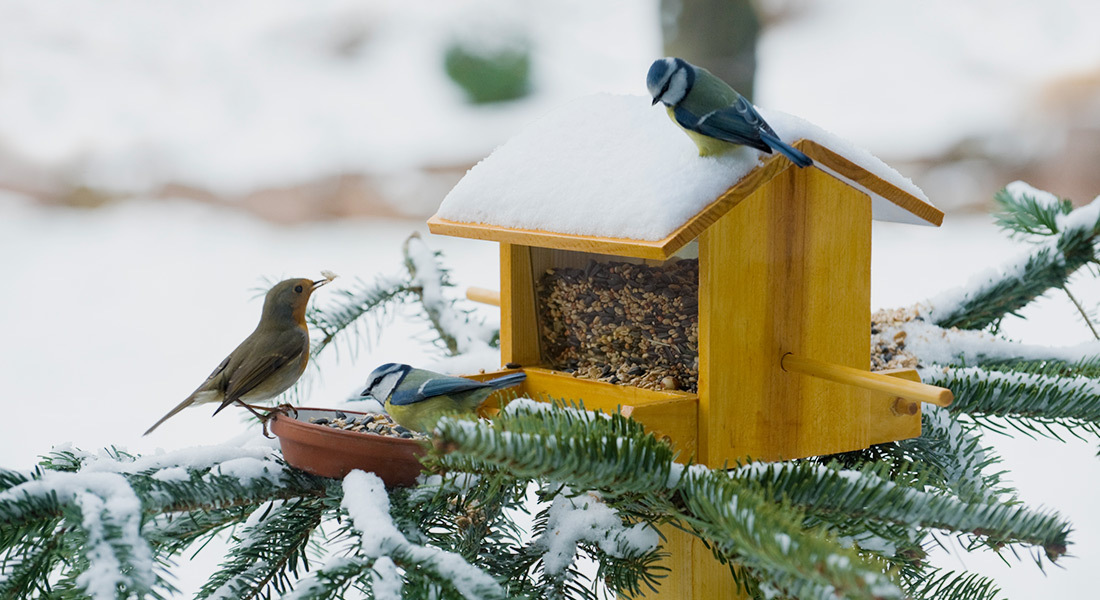How do I help the birds in our area during the cold winter months?

January or February are often the coldest months of the year, with nighttime temperatures dipping close to or below freezing. Birds are warm-blooded, with body temperatures around 106 degrees Fahrenheit. So how do birds keep warm in the winter and what can you do in your yard to help? Food is the key.
Adapting to any environment
Birds have a variety of physical and behavioral adaptations that help keep them warm, no matter how cold it gets. Some birds grow extra feathers in the late fall to give them thicker protection in the winter. Some birds build up fat reserves that insulate them and give them extra energy for generating body heat. Some birds fluff out their feathers to create air pockets for extra insulation in cold temperatures — kind of like the bird version of a puffer jacket. And some birds tuck their bills into their shoulder feathers and use their warm breath to heat up their bodies. This is just a few of the ways birds adapt to the cold.
The common denominator for all is having enough food to eat. Just like us, birds use food to create the energy needed to warm themselves. Here’s how you can help keep them well fed and warm:
- Try a mix of bird feeders. Birds need ready access to food in order to replenish their energy supply. Use different types of feeders with a variety of good, nutritious bird food. Chickadees and finches, for example, head for tube feeders filled with mixed seeds or black-oil sunflower seeds. Woodpeckers, on the other hand, love suet feeders. And birds of all types go for sunflower or safflower-filled hopper feeders. Adding a couple of different types of feeders to your yard can help more birds.
- Keep your feeders full. Especially during the winter, birds need seeds, suet, nuts, peanut butter and other items high in fat and calories. This gives them the energy they need to generate more body heat. By making sure your feeders are always full, birds will know where to go for a high-energy meal — especially after a long, cold night when they need ready-access to nutritious food.
- Stick with high-quality bird feed. Experts note that most human food is either not good for or toxic to birds. Bread, for example, provides no real nutritional value for birds, and moldy bread can harm them. Chocolate is toxic to birds. And table scraps are not only unhealthy for birds, but they can attract mice and rats.
- Provide water that remains liquid. Sure, birds can eat snow, if necessary, as a source for water. But doing so lowers their body temperature and uses extra energy they may not have. If possible, add a heated bird bath to your landscaping. That way, even in freezing temperatures, birds will have a source for water — and a much better chance at winter survival.
Create shelter
Here in southern Oregon, evergreen shrubs and coniferous trees provide excellent shelter for the birds throughout the winter. Adding roost boxes to your yard is also a great winter home for the birds. Consider building a wind break, and throwing seed in sheltered areas of your yard. And building a brush pile can give birds a safe, protected place to roost.
Don’t forget the hummingbirds
In Oregon, most species of hummingbirds migrate for the winter. But there is one species that hangs around year-round: Anna’s Hummingbirds. These tiny wonders weigh just 4-5 grams and require a lot of energy to stay warm. Hummingbird feeders can freeze when the temperature drops. So how can you make sure they have their sugary liquid ready when they need it most? One way is to wrap traditional (non-LED) Christmas lights around the feeder, which will prevent the nectar from freezing (and add a little extra magic to your holiday yard). You can also tape handwarmers to the base of the feeder. Or you can buy any number of feeder heaters that clip to the underside of the feeder to keep it warm. Remember, hummingbirds don’t feed overnight, so you can bring the feeder in at night (to prevent freezing). Just be sure and put it back out first thing in the morning, as this is a key feeding time for the birds.
Share This
